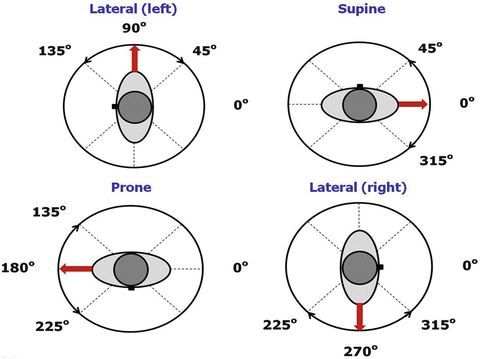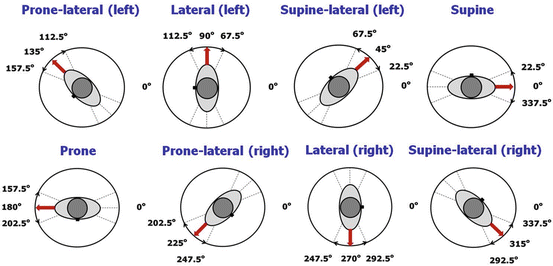1. Supine position
2. Lateral position (left)
3. Prone position
4. Lateral position (right)
5. Upright position: 30 or 45° above the horizontal plane
Table 2
Nine types of sleep position
1. Supine position |
2. Supine-lateral position (left) |
3. Lateral position (left) |
4. Prone-lateral position (left) |
5. Prone position |
6. Prone-lateral position (right) |
7. Lateral position (right) |
8. Supine-lateral position (right) |
9. Upright position: 30 or 45° above the horizontal plane |
Generally, sleep positions in standard (level 1) polysomnography are detected by body position sensor and confirmed by direct monitoring or by a sleep technician using an infrared camera.
In five types of sleep position, four body positions during sleep are classified by 90° ranges and the upright position is defined as a position 30 or 45° above the horizontal plane (Fig. 1). Similarly, in nine types of body position during sleep, eight sleep positions are divided by 45° ranges, and the definition of upright position is the same as stated above (Fig. 2).



Fig. 1
Four sleep positions divided by 90° ranges

Fig. 2
Eight sleep positions divided by 45° ranges
Sleep positions are detected by a position sensor on the trunk. The distribution of sleep position is expressed as the proportion of time spent in each sleep position.
Positional Change During Sleep (Restless Sleep)
Restless sleep or frequent positional change during sleep is a relatively common clinical manifestation in children and adults with OSAS [7]. In our previous data, snoring was the most severe complaint in both groups (Table 3) [7]. In pediatric OSAS, the second serious complaint was mouth breathing, followed by restless sleep, nasal obstruction, and witnessed apnea [7]. In adult OSAS, the second severe symptom and sign was witnessed apnea, followed by restless sleep, mouth breathing, and daytime fatigue [7].
Children with OSAS | Adults with OSAS | |
|---|---|---|
1 | Snoring | Snoring |
2 | Mouth breathing | Witnessed apnea |
3 | Restless sleep | Restless sleep, mouth breathing |
4 | Nasal obstruction | – |
5 | Witnessed apnea | Daytime fatigue |
Although restless sleep is well known as a common symptom and sign related with OSAS, the clear definition or objective assessment of restless sleep has not been established in OSAS. To the best of our knowledge, there has been no research that tried to evaluate the effect of upper airway surgery on restless sleep or positional change during sleep in patients with OSAS except our studies. Therefore, simple definitions of positional change during sleep and index related to positional change or restless sleep were suggested in our researches [18, 19].
Effect of Surgical Treatment for OSAS on Positional Change During Sleep
Effect of Adenotonsillectomy on Positional Change During Sleep in Children with OSAS
In pediatric OSAS, adenotonsillectomy is the first-line treatment because adenotonsillar hypertrophy is the most common etiologic factor [7]. Accumulating studies suggest that adenotonsillectomy is associated with improvements of various symptoms and signs (e.g., snoring, obstructive apnea, behavior, neurocognition, etc.) and OSAS-related quality of life [20, 21]. However, there were few studies in which adenotonsillectomy is objectively related to the alleviation of restless sleep or frequent positional change during sleep in children with OSAS. Therefore, we investigated the effect of adenotonsillectomy on positional change during sleep as determined by an objective sleep test in pediatric patients with OSAS [18].
A total of 22 children (a mean age of 6.6 ± 2.7 years, 16 male and 6 female) with OSAS were included in our study. The frequency of positional change during sleep was estimated using body position sensor (1566-kit, Sleepmate® Technologies) in polysomnography.
There were significant changes in AHI (from 10.7 ± 11.0 to 1.1 ± 1.0; p < 0.001) and arousal index (from 19.9 ± 8.6 to 10.0 ± 4.6; p < 0.001) after adenotonsillectomy. The frequency of position change during sleep reduced in most children (81.8 %) with OSAS, and PCI significantly decreased from 9.3 ± 5.4 to 5.1 ± 2.4 (p < 0.001) postoperatively (Table 4).
Table 4
Study related with PCI during sleep in pediatric OSAS before and after adenotonsillectomy
Study | Group | Before | After | p-value |
|---|---|---|---|---|
Choi et al. [18] | Total (N = 22) | 9.3 ± 5.4 | 5.1 ± 2.4 | 0.001 |
The exact mechanisms or causes of the positional change during sleep in pediatric OSAS are not yet known. Considering the results of this study that frequent positional change during sleep declined with the improvement of AHI and arousal index after adenotonsillectomy, it is thought that respiratory disturbances and/or arousals may be related to positional change during sleep in children with OSAS. It is also postulated that respiratory disturbance and/or arousal may partially contribute to the patient’s discomfort, which, in turn, causes positional change to decrease the discomfort.
Effect of Upper Airway Surgery on Positional Change During Sleep in Adults with OSAS
There are several therapeutic options for OSAS (e.g., PAP, OA, upper airway surgery, behavioral therapy, etc.) [13–17]. Each treatment has its indications, advantages, and disadvantages [10]. Surgical treatment for OSAS can be considered in three conditions including primary (e.g., tonsillar hypertrophy, other severe obstructing upper airway structure), secondary (e.g., inadequate or intolerant of PAP or OA therapy), and adjuvant (e.g., to improve tolerance of other therapy) indications [10]. There are various surgical procedures for OSAS according to the site (e.g., nasal, nasopharyngeal, oropharyngeal, hypopharyngeal, laryngeal, and multilevel procedures) [10]. Numerous studies have shown that successful surgical management is related with alleviation of subjective symptoms and objective polysomnographic parameters [22–24]. However, it is not yet recognized what the effect of upper airway surgery on positional change is during sleep in adult OSAS. Therefore, we assessed whether upper airway surgery for OSAS influences positional change during sleep in adults with or without response [19].
A total of 53 adult patients with OSAS were enrolled in this study and were divided into response (n = 28) and nonresponse (n = 25) groups. The definition of surgical response was achieving a greater than 50 % reduction in AHI before and after surgery. No significant differences were found in baseline data (e.g., age, sex, BMI, AHI, arousal index, PCI, and proportion of time spent in supine position) between the response and nonresponse groups.
In the response group, there were significant changes in AHI (from 45.7 ± 23.9 to 8.6 ± 9.7; p < 0.001) and arousal index (from 45.6 ± 21.5 to 23.1 ± 10.9; p < 0.001) after upper airway surgery. In addition, the PCI significantly reduced from 4.2 ± 3.8 to 2.6 ± 1.6 (p = 0.038) (Table 5). However, in the nonresponse group, no significant postoperative changes were found in AHI, arousal index, and PCI.
Table 5
Study related with PCI during sleep in adult OSAS before and after upper airway surgery
Study | Group | Before | After | p-value |
|---|---|---|---|---|
Choi et al. [19] | Response (n = 28) | 4.2 ± 3.8 | 2.6 ± 1.6 | 0.038 |
Nonresponse (n = 25) | 3.4 ± 2.0 | 3.4 ± 2.1 | NS |
In adult OSAS, little is also known about the exact mechanisms or etiologies of positional change during sleep. As mentioned above (section “Effect of Adenotonsillectomy on Positional Change During Sleep in Children with OSAS”), these results suggest that the respiratory disturbances and/or arousals are partially related with restless sleep or frequent positional change during sleep in adult OSAS. Also, it is presumed that respiratory disturbances and/or arousals may influence discomfort of the patient, which, in turn, causes positional change during sleep to alleviate the discomfort.
Stay updated, free articles. Join our Telegram channel

Full access? Get Clinical Tree






